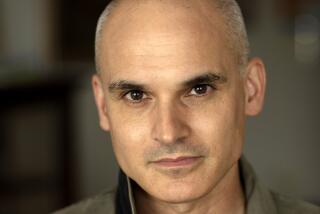BOOK REVIEW : ‘Trick’ Falls Short of Being a Treat : TRICK OF THE EYE, <i> by Jane Stanton Hitchcock</i> , Dutton $19; 277 pp.
- Share via
Painter Faith Crowell, the narrator of this first novel, tells us early on that she considers herself at age 39 to be a spinster, long since reconciled to leading “a well-ordered, uneventful life, grisaille as opposed to color-plated.” A craftsman rather than an artist, Faith is content, if not happy, with her lot; she loves to paint, has earned professional respect and a decent income and claims enough friends to make her bouts of loneliness endurable.
What makes Faith interesting is her special skill--that as proprietor and sole employee of Trompe L’Oeil Inc., or Trick of the Eye, she paints faux finishes for a living. Faith is interested, she says, in “the beauty of illusion” and knows from personal and professional experience that “imitators must exaggerate in order to fool others.” She seems, in short, the perfect amateur detective, because Faith’s work has necessarily made her “good at spotting cover-ups. They were, after all, my trade.”
Jane Stanton Hitchcock, a playwright, has created in Faith a fresh and likable protagonist. Faith does not live up to her rather vain self-description, however, for although she tries to keep up with the various plot twists devised by Hitchcock, the reader is always a few steps ahead of her. That’s a problem in a suspense novel, though perhaps not a serious one in a book that aspires--by emphasizing the contrast between surface and depth, image and substance--to a certain literary status.
Still, it’s doubtful Hitchcock wants readers to regard Faith as a little dim although, given the nature of Faith’s work, it’s easy to believe she has no particular facility for envisioning the big picture.
It’s both a little strange and quite appropriate, consequently, that a big picture lies at the heart of “Trick of the Eye”--a commission from the fabulously wealthy, famously tasteful Frances Griffin to paint a mural in the ballroom of her Long Island mansion.
Built for the coming-out party of Frances’ daughter Cassandra, the room was used only once, primarily because of Cassandra’s mysterious murder at the estate a few years later. Faith believes, for good reason, that Frances has commissioned the mural in Cassandra’s honor and that Faith’s selection for the job is the result of her trompe l’oeil skills, but she’s only partly correct.
Frances in fact has much more profound plans for Faith--plans that rely on Faith’s being significantly more superficial than her chosen line of work.
Hitchcock, to her credit, has a complicated response to the idea of superficiality.
Faith’s work at first seems shallow, but it rewards close observation; Frances’ deep appreciation of art--she eventually inspires Faith to do her best painting ever--is less honest than it initially appears.
Hitchcock doesn’t do much with the opportunities she’s created, however, for as soon as Faith tells us how much she identifies with Cassandra, we know pretty much how “Trick of the Eye” is going to play out.
Faith determines to solve Cassandra’s murder with the help of her best friend, Harry Pitt, and spends an inordinate amount of time knocking down the straw suspects that Hitchcock erects.
Like Edmund Wilson with regard to Roger Ackroyd, we don’t much care who killed Cassandra, for Hitchcock hasn’t made murder essential to the novel’s plot: “Trick of the Eye” would have worked just as well if Cassandra’s premature death had been of natural causes. The biggest red herring in this novel, ironically, is not some painting but the murder itself.
Great wealth, Long Island estates, self-invention, the discerning, God-like eye, sudden death--intentionally or not, Hitchcock has laced “Trick of the Eye” with numerous echoes of “The Great Gatsby.”
Hitchcock, clearly, has serious ambitions as a writer, and it’s too bad that this attempt to marry literary themes to the murder mystery form never quite comes together.
Faith needed a ruthless patron to force her to do her best work, and it seems that Hitchcock--again like Fitzgerald--may have needed a more attentive editor to do hers.
More to Read
Sign up for our Book Club newsletter
Get the latest news, events and more from the Los Angeles Times Book Club, and help us get L.A. reading and talking.
You may occasionally receive promotional content from the Los Angeles Times.










